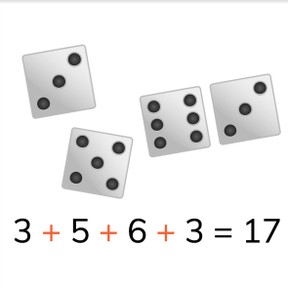



8,000 schools use Gynzy
92,000 teachers use Gynzy
1,600,000 students use Gynzy
General
Students learn to add 3 or more addends with totals to 20.
Common core standard(s)
-1.OA.C
Relevance
It is important to be able to add multiple addends. In some situations it is impossible otherwise. An example would be when doing groceries, seeing groups of animals, or when you're playing a game with multiple dice.
Introduction
First practice two addition problems with students on the interactive whiteboard. They are story problems with visual support.
Development
First discuss the value of being able to add multiple addends. Next, explain that the first addend is the number that you have, and that the rest of the addends are joining the first number. Tell the students that they may swap addends if that is easier for them. Next the learning goal is explained visually, in the abstract, and as story problems. You can choose which method to discuss with your class by using the menu in the bottom right of the page. Otherwise, start with the explanation in visual form, so the addition problems with visual support. Explain, using the images, how you can add a number with multiple addends. Next discuss the abstract addition problems with only numbers. If you want to make this visual for your students, you can move the cover on the slide to show the blocks. Finally discuss the steps in a story problem. Students can click on the speaker to hear the story read aloud. Each element has the teacher explain how it works, practice together and a problem for the students to try.
Check that students understand adding to 20 with 3 or more addends by asking the following questions:
- Why is it useful to be able to add multiple addends?
- How do you add a number with multiple addends? What do you do first? And then?
Guided practice
Students first practice problems with visual support, then do an abstract problem, and then a story problem.
Closing
You can play two games. The first game is 20-stack, a game derived from blackjack. Give the students a pack of cards (without face cards) or number cards to 10 or to 20. The dealer gives each student one card, and then asks if they want a second card, or third card, etc. Students try to get 20 points. If a student gets more than 20 points, they are out. The student who is closest to 20 wins a point. Then it starts again.
The second game is a dice game with three or four dice. The student who throws the highest number gets a point, but if they throw a number larger than 20, they get a minus-point.
Teaching tips
Students who have difficulty adding can be supported by the use of blocks or other manipulatives.
Instruction materials
Pack of cards, or number cards to 10 or 20.
And/or 4 dice per group of 4/5 students.
Optional: blocks or manipulatives
The online teaching platform for interactive whiteboards and displays in schools
Save time building lessons
Manage the classroom more efficiently
Increase student engagement
Discover more!
About Gynzy
Gynzy is an online teaching platform for interactive whiteboards and displays in schools.
With a focus on elementary education, Gynzy’s Whiteboard, digital tools, and activities make it easy for teachers to save time building lessons, increase student engagement, and make classroom management more efficient.



